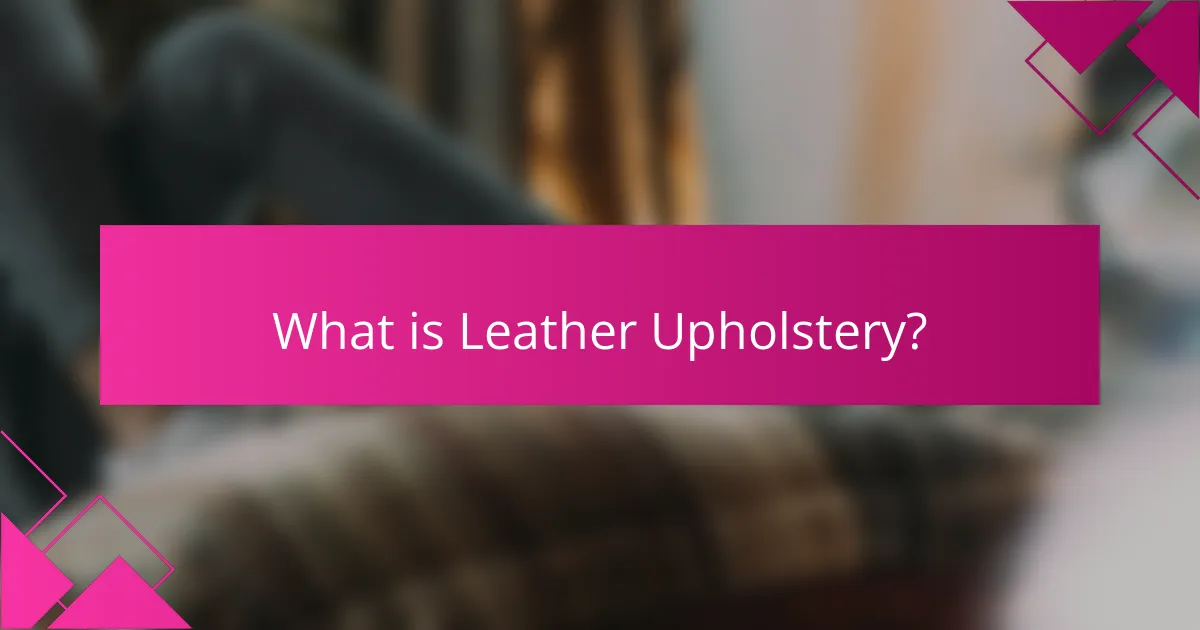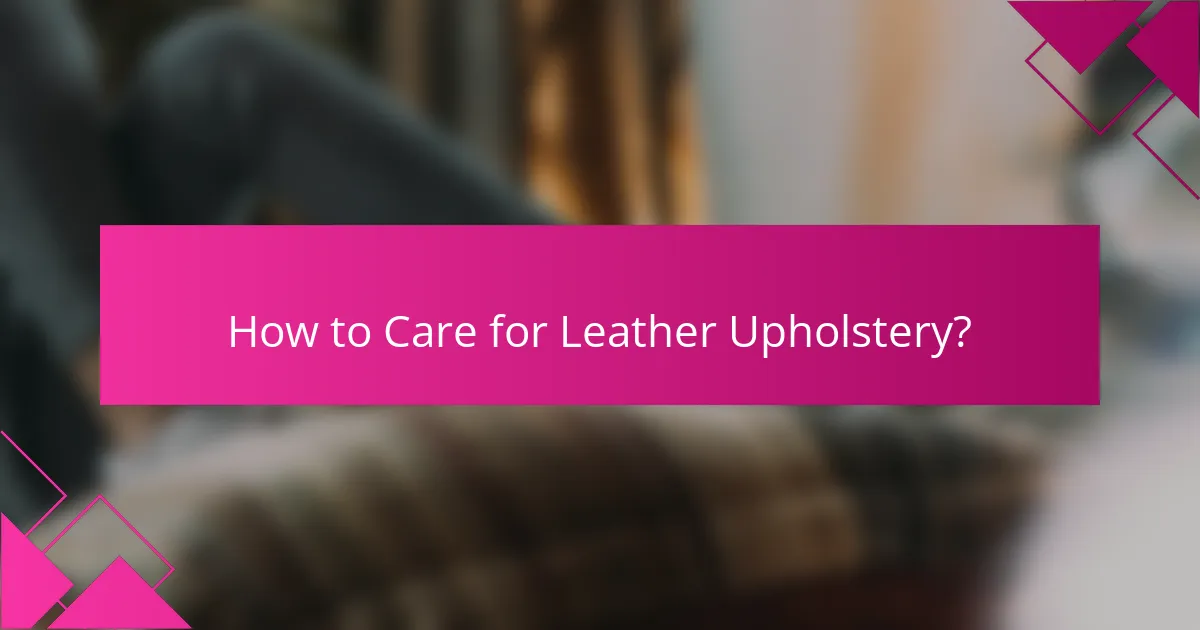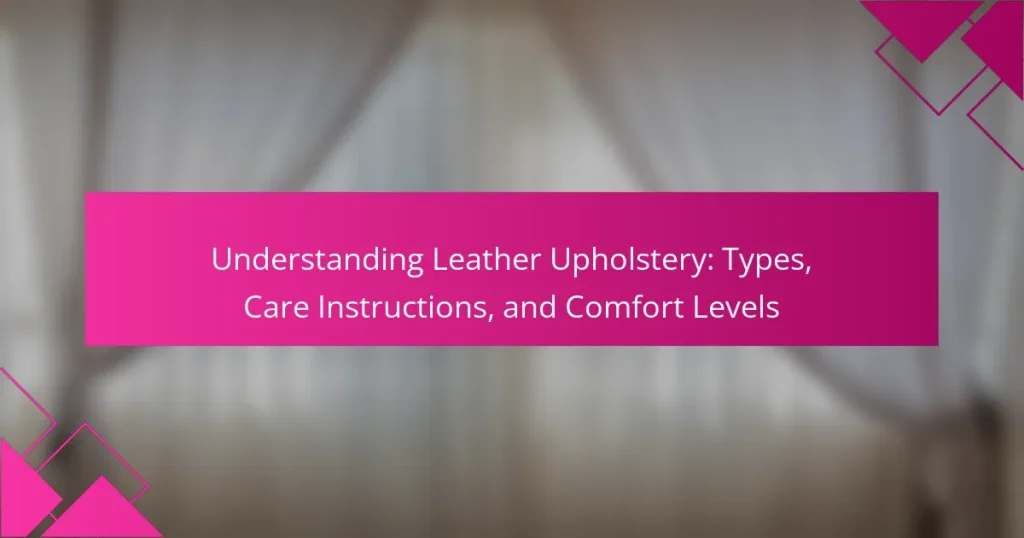Leather upholstery is a durable and aesthetically appealing furniture covering made from animal hide, commonly used in sofas, chairs, and other furnishings. This material comes in various types, including full-grain, top-grain, and bonded leather, each with distinct qualities affecting texture and longevity. Proper care, such as regular cleaning and conditioning, is essential to maintain the appearance and extend the life of leather upholstery. Additionally, leather offers high comfort levels due to its natural properties, breathability, and support, making it a preferred choice over synthetic alternatives. This article provides a comprehensive overview of leather upholstery, including its types, care instructions, and comfort features.

What is Leather Upholstery?
Leather upholstery is a type of furniture covering made from animal hide. It is commonly used for sofas, chairs, and other furnishings. Leather is valued for its durability and aesthetic appeal. This material can be treated and finished in various ways, affecting its texture and appearance. Common types of leather upholstery include full-grain, top-grain, and bonded leather. Full-grain leather is the highest quality, retaining the natural texture of the hide. Top-grain leather is slightly processed, making it more uniform. Bonded leather is made from scraps and is less durable. Leather upholstery requires specific care to maintain its appearance and longevity. Regular cleaning and conditioning are essential for preserving its quality.
How is Leather Upholstery Made?
Leather upholstery is made through a detailed process that begins with the selection of raw hides. These hides are typically sourced from cattle and are then cleaned and preserved through tanning. Tanning transforms the raw hides into durable leather by using chemicals or natural substances. After tanning, the leather is dyed to achieve the desired color and finish.
Next, the leather is cut into specific shapes to fit furniture designs. Skilled craftsmen sew these pieces together, ensuring strong seams for durability. Finally, the upholstered furniture is assembled, incorporating padding and frames for added comfort. This process results in high-quality leather upholstery that is both functional and aesthetically pleasing.
What are the raw materials used in Leather Upholstery?
The raw materials used in leather upholstery primarily include animal hides, tanning agents, and finishing chemicals. Animal hides, typically from cows, goats, or pigs, serve as the main component. Tanning agents, such as chromium salts or vegetable tannins, are essential for preserving the hides. Finishing chemicals, including dyes and protective coatings, enhance the appearance and durability of the leather. These materials work together to create high-quality leather upholstery suitable for various applications.
What are the stages involved in producing Leather Upholstery?
The stages involved in producing leather upholstery include several key processes. First, raw hides are sourced from animals, primarily cattle. Next, the hides undergo a tanning process to preserve them and enhance durability. After tanning, the leather is dyed to achieve the desired color and finish. Following dyeing, the leather is conditioned to ensure softness and flexibility. Then, the leather is cut into patterns for upholstery applications. Next, the pieces are sewn together to create the final product. Finally, the leather upholstery is inspected for quality before being packaged for distribution. Each of these stages is crucial in ensuring high-quality leather upholstery.
What are the Different Types of Leather Upholstery?
The different types of leather upholstery include full-grain, top-grain, corrected grain, and bonded leather. Full-grain leather is made from the top layer of the hide and retains natural imperfections. It is known for its durability and breathability. Top-grain leather is also made from the top layer but is sanded and treated for a smoother finish. It is more stain-resistant than full-grain. Corrected grain leather undergoes additional processing to correct flaws, making it less expensive. Bonded leather consists of leftover leather scraps bonded together, offering a lower-cost alternative. Each type has distinct characteristics that affect its quality and usage in upholstery.
What are the characteristics of Full-Grain Leather?
Full-grain leather is characterized by its natural surface and durability. It retains the original grain of the hide, showcasing unique imperfections and markings. This type of leather is known for its breathability, allowing air circulation. Full-grain leather develops a rich patina over time, enhancing its appearance. It is resistant to wear and tear, making it suitable for high-quality products. Additionally, full-grain leather is often more expensive due to its premium quality. The tanning process used preserves the hide’s natural characteristics, contributing to its longevity.
How does Top-Grain Leather differ from other types?
Top-grain leather differs from other types by having the second-highest quality among leather grades. It is made from the top layer of animal hide, retaining some natural grain for a more authentic appearance. Unlike full-grain leather, top-grain leather is sanded and treated to remove imperfections. This process makes it smoother and more uniform in texture. However, it sacrifices some durability and breathability compared to full-grain leather. Top-grain leather is also more resistant to stains and easier to clean than other types, such as corrected-grain leather. Its balance of quality and affordability makes it a popular choice for furniture and accessories.
What is the significance of Bonded Leather in upholstery?
Bonded leather is significant in upholstery due to its cost-effectiveness and eco-friendliness. It is made from leather scraps that are bonded together with a polyurethane or latex backing. This process creates a material that mimics the appearance of genuine leather while being more affordable. Bonded leather is often used in furniture, automotive interiors, and accessories. Its durability is enhanced by the bonding process, making it resistant to wear and tear. Additionally, bonded leather can be easier to clean compared to traditional leather. The use of recycled materials in its production contributes to sustainability in the upholstery industry.
What are the Benefits of Leather Upholstery?
Leather upholstery offers durability and longevity. It can last for decades with proper care. Leather is also easy to clean and maintain. Spills can be wiped away without staining. Additionally, leather provides a luxurious and sophisticated appearance. It enhances the aesthetic value of furniture. Leather upholstery is resistant to wear and tear. This makes it a practical choice for high-traffic areas. Furthermore, leather has natural breathability, which adds to comfort. Studies show that leather can improve seating comfort over time.
How does Leather Upholstery enhance interior aesthetics?
Leather upholstery enhances interior aesthetics by adding a touch of luxury and sophistication. Its rich texture and natural sheen elevate the visual appeal of any space. Leather is available in various colors, allowing for versatile design options. This material complements both modern and traditional decor styles. Additionally, leather’s durability ensures it maintains its appearance over time. The material can be easily cleaned, preserving its elegance. Its ability to age gracefully adds character to the interior. Overall, leather upholstery contributes to a refined and inviting atmosphere.
What are the durability advantages of Leather Upholstery?
Leather upholstery is known for its exceptional durability. It can withstand wear and tear better than many other materials. High-quality leather can last for decades with proper care. Leather is resistant to spills and stains, making it easier to maintain. Its natural fibers allow it to breathe, reducing the risk of mold and mildew. Additionally, leather develops a unique patina over time, enhancing its aesthetic appeal. Studies show that leather furniture can retain its value better than fabric options. This longevity makes leather a cost-effective choice over time.

How to Care for Leather Upholstery?
To care for leather upholstery, regularly clean it with a soft, dry cloth. This prevents dust and dirt buildup. Use a leather cleaner specifically designed for upholstery. Apply the cleaner according to the manufacturer’s instructions. Condition the leather every 6 to 12 months to maintain its suppleness. Leather conditioner replenishes natural oils and prevents cracking. Avoid direct sunlight and heat sources to prevent fading and drying. If spills occur, blot them immediately with a soft cloth. Do not rub, as this can damage the leather’s surface. Regular maintenance extends the life of leather upholstery significantly.
What are the Basic Cleaning Techniques for Leather Upholstery?
To clean leather upholstery, start by dusting the surface with a soft cloth. This removes loose dirt and debris. Next, use a damp cloth with mild soap to gently wipe the leather. Avoid soaking the leather, as excess moisture can damage it. After cleaning, dry the surface with a clean, dry cloth. Apply a leather conditioner to maintain suppleness and prevent cracking. Regular cleaning every few months helps preserve the leather’s appearance and longevity.
How often should Leather Upholstery be cleaned?
Leather upholstery should be cleaned every 6 to 12 months. Regular cleaning helps maintain its appearance and longevity. Dust and dirt can accumulate, leading to wear over time. Using a soft cloth and a leather cleaner is recommended. This prevents damage and keeps the leather supple. Additionally, conditioning every 6 months can enhance its durability. Following these guidelines ensures that leather upholstery remains in good condition.
What cleaning products are safe for Leather Upholstery?
Cleaning products safe for leather upholstery include pH-balanced leather cleaners, distilled water, and mild soap. These products do not damage the leather’s surface. Avoid harsh chemicals, alcohol-based cleaners, and ammonia. Using a soft cloth for application prevents scratches. Regular conditioning with leather conditioner maintains suppleness. These practices extend the lifespan of leather upholstery.
What are the Best Practices for Maintaining Leather Upholstery?
The best practices for maintaining leather upholstery include regular cleaning, conditioning, and protecting the leather. Cleaning should be done with a soft, damp cloth to remove dust and dirt. Conditioning helps to keep the leather supple; use a quality leather conditioner every 6 to 12 months. Protecting leather from direct sunlight and heat sources prevents fading and drying. Avoid using harsh chemicals or abrasive materials that can damage the surface. Spills should be wiped immediately with a clean cloth to prevent staining. Regularly check for signs of wear and address them promptly to extend the life of the upholstery. Following these practices can significantly enhance the longevity and appearance of leather upholstery.
How can you prevent cracking and fading in Leather Upholstery?
To prevent cracking and fading in leather upholstery, regularly condition the leather with a high-quality leather conditioner. This helps maintain moisture and suppleness. Additionally, keep leather away from direct sunlight and heat sources to minimize fading. Use protective covers or window treatments to shield it from UV rays. Clean leather upholstery with a damp cloth and avoid harsh chemicals that can damage the surface. Regularly dust the leather to remove dirt and debris that can cause wear. Following these care practices can significantly extend the life of leather upholstery and maintain its appearance.
What should you do if Leather Upholstery gets stained?
Blot the stain immediately with a soft, dry cloth. This prevents the stain from setting into the leather. If the stain persists, use a leather cleaner specifically designed for upholstery. Apply the cleaner according to the manufacturer’s instructions. Test the cleaner on a hidden area first to avoid discoloration. For oil-based stains, sprinkle cornstarch or talcum powder on the area to absorb the oil. Allow it to sit for several hours before gently brushing it off. Regular conditioning of leather can help prevent future stains.

What Comfort Levels Can You Expect from Leather Upholstery?
Leather upholstery offers a high level of comfort due to its natural properties. It is soft to the touch and molds to the body over time. This material provides good support, enhancing the seating experience. Leather also has breathability, which helps regulate temperature. It remains cool in warm conditions and warm in cooler environments. The comfort level can vary based on the type of leather used, such as full-grain or top-grain. High-quality leather can last for years, maintaining its comfort over time. Additionally, leather upholstery is easy to clean, contributing to a more pleasant seating experience. Studies show that leather furniture is often rated higher in comfort compared to synthetic alternatives.
How does Leather Upholstery compare to Fabric Upholstery in Comfort?
Leather upholstery generally provides a different comfort experience compared to fabric upholstery. Leather tends to be firmer and can feel cooler to the touch initially. It adapts to body temperature over time, offering a warmer feel as it warms up. Fabric upholstery is typically softer and more breathable, which can enhance comfort in warmer climates.
Leather is less prone to absorbing moisture, making it easier to clean and maintain. However, it may feel sticky in hot weather. Fabric upholstery can retain heat and moisture, which might lead to discomfort in humid conditions.
Studies show that personal preference plays a significant role in perceived comfort. Some individuals prefer the luxurious feel of leather, while others favor the cozy texture of fabric. Ultimately, comfort levels vary based on individual preferences and environmental factors.
What factors influence the comfort level of Leather Upholstery?
The comfort level of leather upholstery is influenced by several factors. These include the quality of the leather, which directly affects softness and durability. Full-grain leather tends to be more comfortable than corrected-grain leather due to its natural texture. The type of padding underneath the leather also plays a crucial role in comfort. High-density foam provides better support and cushioning. Additionally, the design and construction of the furniture impact how well it conforms to the body. Proper ventilation in leather upholstery can enhance comfort by preventing overheating. Finally, maintenance practices, such as conditioning, can keep the leather supple and comfortable over time.
How does climate affect the comfort of Leather Upholstery?
Climate significantly impacts the comfort of leather upholstery. High humidity levels can cause leather to become damp and sticky. This discomfort can lead to an unpleasant seating experience. Conversely, dry climates can lead to leather drying out and cracking. This deterioration affects both aesthetics and comfort. Temperature extremes can also influence leather’s feel. In colder conditions, leather can feel chilly against the skin. In warm conditions, it may feel overly warm and uncomfortable. Therefore, maintaining a stable climate is essential for optimal leather comfort.
What are the Recommendations for Choosing Comfortable Leather Upholstery?
Choose high-quality leather for comfort. Full-grain leather offers durability and breathability. Look for upholstery with a soft finish to enhance comfort. Consider the leather’s thickness; thicker leather can provide more support. Ensure the leather is treated for stain resistance. Check for proper cushioning in the furniture frame. Test the seating firmness to find your comfort level. Lastly, consider the leather’s temperature regulation properties for year-round comfort.
How do different leather types impact seating comfort?
Different leather types significantly impact seating comfort. Full-grain leather offers durability and breathability, enhancing comfort over time. Top-grain leather is softer and more pliable, providing immediate comfort but may wear faster. Genuine leather, while affordable, can be less breathable and may not conform to body shape as well. Suede, being softer, provides a cozy feel but can be less durable and harder to clean. Bonded leather is less expensive but often lacks the comfort and longevity of higher-quality leathers. Each leather type’s texture, breathability, and durability play crucial roles in the overall seating experience.
What should you consider when selecting Leather Upholstery for specific uses?
When selecting leather upholstery for specific uses, consider the type of leather. Different leather types have varying durability and aesthetics. Full-grain leather is the most durable and develops a patina over time. Top-grain leather is slightly less durable but offers a more uniform appearance.
Assess the intended use, such as residential or commercial. Residential uses may prioritize comfort, while commercial uses require higher durability. Evaluate the maintenance requirements of the leather type. Some leathers require regular conditioning to maintain appearance.
Consider the color and texture for design compatibility. Lighter colors may show stains more easily, while darker shades can hide imperfections. Finally, check for any specific treatments that enhance stain resistance or water repellency. These factors ensure the leather upholstery meets the functional and aesthetic needs of the space.
What are Common Issues with Leather Upholstery Comfort?
Common issues with leather upholstery comfort include temperature sensitivity, lack of breathability, and potential for stiffness. Leather can become hot in warm weather and cold in cooler conditions. This temperature sensitivity can lead to discomfort during prolonged use. Additionally, leather lacks breathability compared to fabric upholstery. This can cause sweating and discomfort, especially in humid environments. Over time, leather may also become stiff or lose its softness. This stiffness can reduce overall comfort during sitting or reclining. Regular maintenance can mitigate some of these issues, but they remain common concerns for leather upholstery users.
How can you address discomfort in Leather Upholstery?
To address discomfort in leather upholstery, consider using a leather conditioner. Leather conditioners restore moisture and suppleness, making the surface more comfortable. Regular application can prevent stiffness and cracking. Additionally, ensure proper ventilation in the area. Good airflow helps reduce heat buildup, enhancing comfort. Use seat cushions or throws for added softness. These can provide extra padding and support. Lastly, avoid direct sunlight exposure. Prolonged sunlight can dry out leather, leading to discomfort.
What are the signs that your Leather Upholstery needs replacement?
Signs that your leather upholstery needs replacement include visible cracks and tears. These damages indicate that the material has lost its integrity. Another sign is significant discoloration or fading. This occurs due to prolonged exposure to sunlight and wear. Additionally, if the upholstery has a persistent unpleasant odor, it may be a sign of underlying damage. Peeling or flaking leather also suggests that the material is deteriorating. Lastly, if the upholstery feels stiff or rough to the touch, it may no longer provide comfort or support.
Leather upholstery is a furniture covering made from animal hide, valued for its durability and aesthetic appeal. This article provides an in-depth exploration of leather upholstery, including its various types such as full-grain, top-grain, and bonded leather, along with the production process, raw materials, and care instructions necessary to maintain its quality. Additionally, it examines the comfort levels associated with leather upholstery, factors influencing comfort, and best practices for selection and maintenance. Understanding these aspects will help consumers make informed decisions regarding leather upholstery for their furniture needs.


